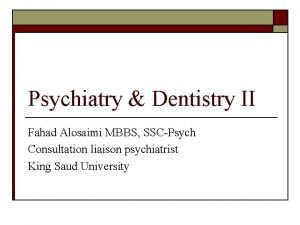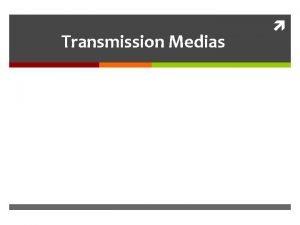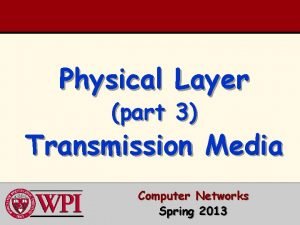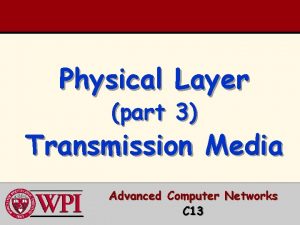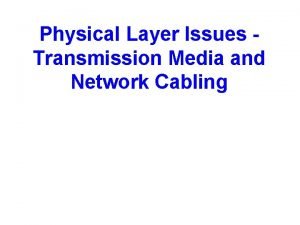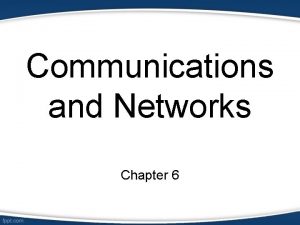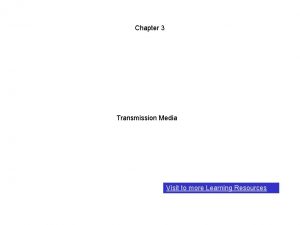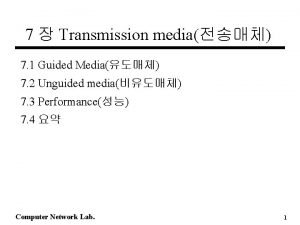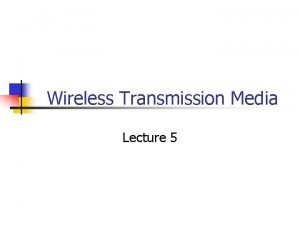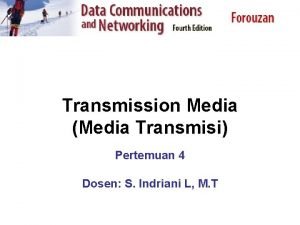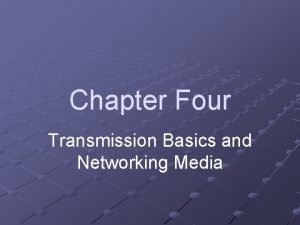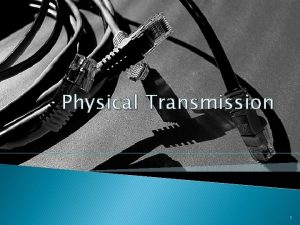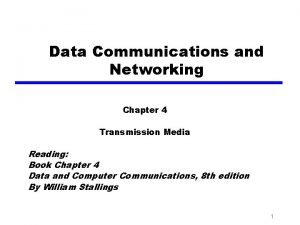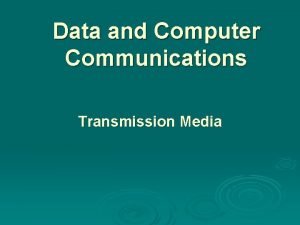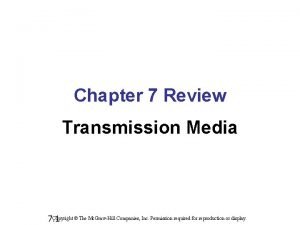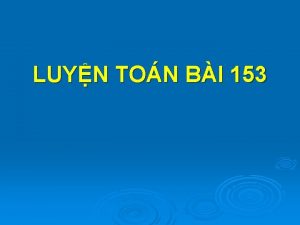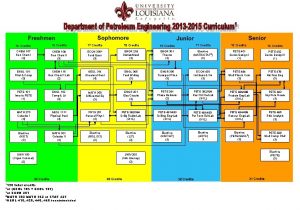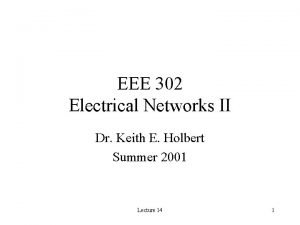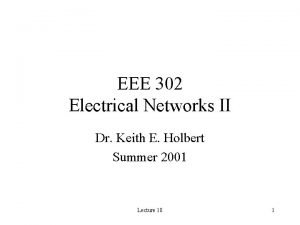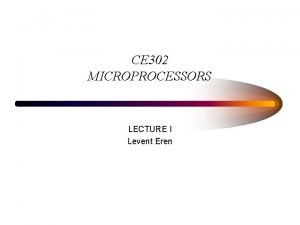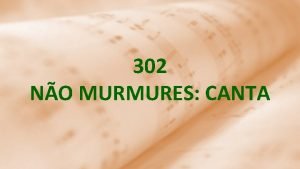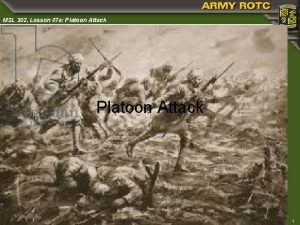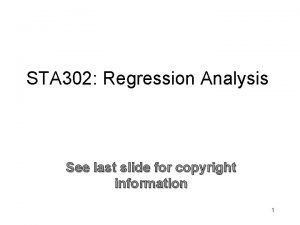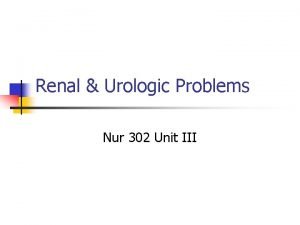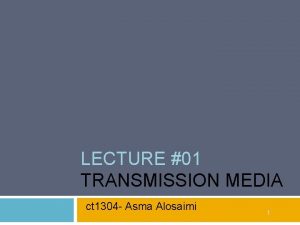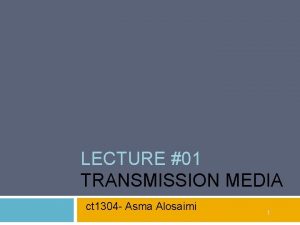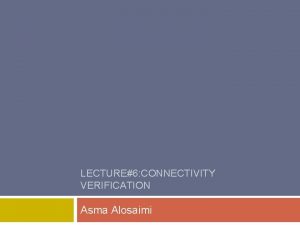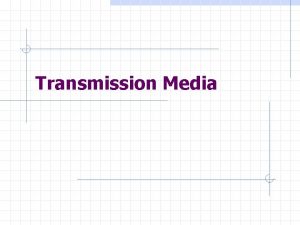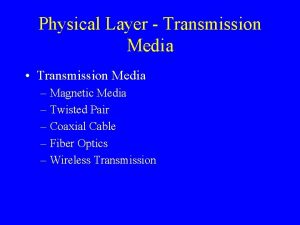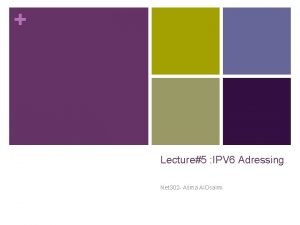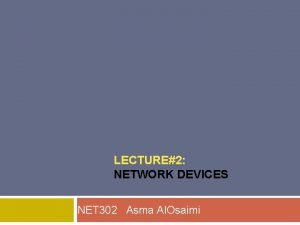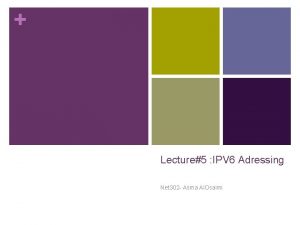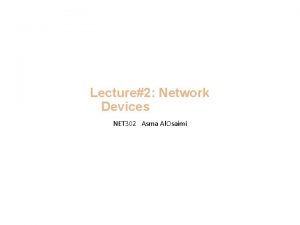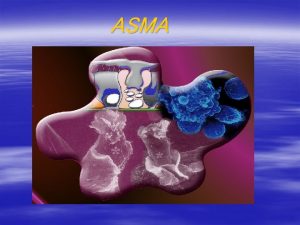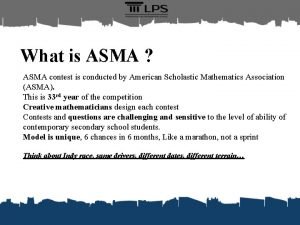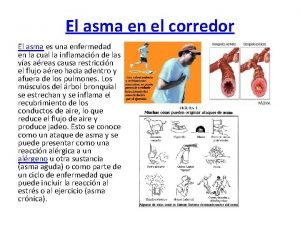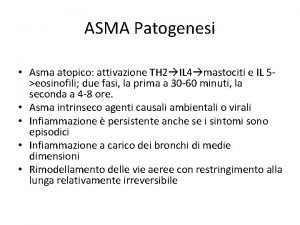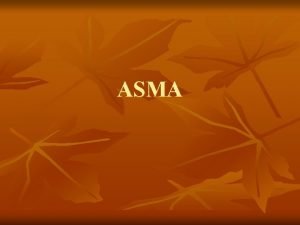LECTURE 01 TRANSMISSION MEDIA NET 302 Asma Alosaimi































- Slides: 31

LECTURE #01 TRANSMISSION MEDIA NET 302 - Asma Alosaimi 1

Topics: 2 Review � Transmission media types � UTP � STP � Wireless Media �

The two models Data Link Header IP Header TCP Header HTTP Header Data Link Trailer 3

Protocol Suites 4 TCP/IP Protocol Suite and Communication

Data Encapsulation Protocol Data Units (PDUs) 5

Getting it Connected Connecting to the Network 6 A physical connection can be a wired connection using a cable or a wireless connection using radio waves. �

Getting it Connected Connecting to the Network 7 Switches and wireless access points are often two separate dedicated devices, connected to a router. Many homes use integrated service routers (ISRs), � �

Getting it Connected Network Interface Cards 8 � � Network Interface Cards (NICs) connect a device to the network. Ethernet NICs are used for a wired connection whereas WLAN (Wireless Local Area Network) NICs are used for

Getting it Connected Network Interface Cards 9 Connecting to the Wireless LAN with a Range Extender � Wireless devices must share access to the airwaves connecting to the wireless access point. � � Slower network performance may occur A wired device does not need to share its access � Each wired device has a separate communications channel over its own Ethernet cable.

10 The Physic al Layer � � Encoding or line encoding - Method of converting a stream of data bits into a predefined "codes”. Signaling - The physical layer must generate the electrical, optical, or wireless signals that represent the "1" and "0" on the media.

Purpose of the Physical Layer Media 11 � � The physical layer produces the representation and groupings of bits for each type of media as: Copper cable: The signals are patterns of electrical pulses. ( Focus on STP & UTP) Fiber-optic cable: The signals are patterns of light. ( details in NET 301) Wireless: The signals are patterns of microwave transmissions. ( brief description only )

Fundamental Principles of Layer 1 Bandwidth 12 Bandwidth is the capacity of a medium to carry data. � Typically measured in kilobits per second (kb/s) or megabits per second (Mb/s). �

Fundamental Principles of Layer 1 Throughput 13 � � Throughput is the rate of packets delivered successfully Due to a number of factors, throughput usually does not match the specified bandwidth in physical layer implementations. http: //www. speedtest. net/ http: //ipv 6 -test. com/speedtest/

Throughput vs Bandwidth 14 Bandwidth number of cars that can pass the highway in a given time. Throughput is the number of cars that reached the destination successfully.

Network Symbols 15

PHYSICAL MEDIA 16

Fundamental Principles of Layer 1 Types of Physical Media 17 � Different types of interfaces and ports available on a 1941 router

18 Copper Cabling Copper Media

Copper Cabling Characteristics of Copper Media 19 2 1 4 3 � � Signal attenuation - the longer the signal travels, the more it deteriorates - susceptible to interference Crosstalk - a disturbance caused by the electric or magnetic fields of a signal on one wire to the signal in an adjacent wire.

Copper Cabling 20 Unshielded Twisted-Pair (UTP) Cable

Copper Cabling UTP Categories Category 1 Voice only (Telephone) Category 2 Data to 4 Mbps (Localtalk) Category 3 Data to 10 Mbps (Ethernet) Category 4 Data to 20 Mbps (Token ring) Category 5 e Data to 100 Mbps (Fast Ethernet) Data to 1000 Mbps (Gigabit Ethernet) Category 6 Data to 2500 Mbps (Gigabit Ethernet)

Copper Cabling UTPRJ 45 connector

Copper Cabling UTP 23 � EIA/TIA-568 A/B compliant refers to which of the four pairs in the UTP cable are designated as transmit, and which are designated as receive. Use the following as a guide: � � EIA/TIA-568 A: Devices transmit over pair 3, and receive over pair 2. EIA/TIA-568 B: Devices transmit over pair 2, and receive over pair 3.

Copper Cabling Termination — EIA/TIA-568 A 24

Copper Cabling Termination — EIA/TIA-568 B 25

Copper Cabling 26 UTP Implementation: Straight. Through

Copper Cabling UTP Implementation: Cross. Over 27

Copper Cabling Straight-Through Vs. Crossover 28 � Use straight-through cables for the following cabling: � Use crossover cables for the following cabling: � Switch to Switch. � Switch to Router. � Switch to Hub. � Switch to Server (PC). � Hub to Hub. � Hub to Server (PC). � Router to Router. � PC to PC

Copper Cabling Shielded Twisted-Pair (STP) Cable 29 Braided or Foil Shields • UTP cable does not use shielding to counter the effects of EMI and RFI. Instead, cable designers have discovered that they can limit the negative effect of crosstalk • STP cable combines the techniques of shielding to counter EMI and RFI and wire twisting to counter crosstalk.

Wireless Media 3) Wireless Media 30 • • IEEE 802. 11 standards Commonly referred to as Wi-Fi. Uses CSMA/CA Variations include: • • • 802. 11 a: 54 Mbps, 5 GHz 802. 11 b: 11 Mbps, 2. 4 GHz 802. 11 g: 54 Mbps, 2. 4 GHz 802. 11 n: 600 Mbps, 2. 4 and 5 GHz 802. 11 ac: 1 Gbps, 5 GHz 802. 11 ad: 7 Gbps, 2. 4 GHz, 5 GHz, and 60 GHz • IEEE 802. 15 standard • Supports speeds up to 3 Mbps • Provides device pairing over distances from 1 to 100 meters. • IEEE 802. 16 standard • Provides speeds up to 1 Gbps • Uses a point-to-multipoint topology to provide wireless broadband access.

Recourses: 31 Rehab Al. Fallaj , lecture notes � Cisco slides �
 Difference between psychosis and neurosis
Difference between psychosis and neurosis 01:640:244 lecture notes - lecture 15: plat, idah, farad
01:640:244 lecture notes - lecture 15: plat, idah, farad Guided media
Guided media Transmission
Transmission Transmission media in computer network
Transmission media in computer network Transmission media
Transmission media What are the two types of transmission media?
What are the two types of transmission media? Transmission media in data communication
Transmission media in data communication Antenna looks like a gigantic scoop.
Antenna looks like a gigantic scoop. Wireless transmission media examples
Wireless transmission media examples Transmission media
Transmission media Physical layer transmission media
Physical layer transmission media Transmission basics and networking media
Transmission basics and networking media Physical transmission media
Physical transmission media Physical transmission media
Physical transmission media Transmission medias
Transmission medias Transmission medium
Transmission medium Transmission medias
Transmission medias 7285 x 302
7285 x 302 302 commitment
302 commitment Mat 302 bmcc
Mat 302 bmcc Growth and development definition
Growth and development definition Eee 302
Eee 302 Eee 302
Eee 302 Ce 302
Ce 302 Invés de murmurares canta
Invés de murmurares canta A 405-n rightward force
A 405-n rightward force Lesson 302
Lesson 302 Bus 302 csun
Bus 302 csun Dajal bull
Dajal bull Sta 0-368
Sta 0-368 Nur 302
Nur 302
